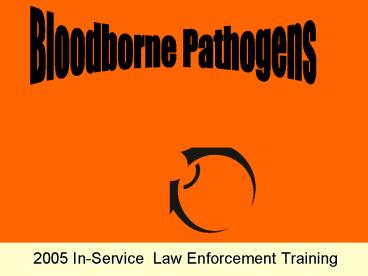2005 InService Law Enforcement Training - PowerPoint PPT Presentation
1 / 33
Title:
2005 InService Law Enforcement Training
Description:
Describe the general symptoms and epidemiology of bloodborne diseases. Identify the modes of transmission for bloodborne pathogens. ... – PowerPoint PPT presentation
Number of Views:436
Avg rating:3.0/5.0
Title: 2005 InService Law Enforcement Training
1
Bloodborne Pathogens
- 2005 In-Service Law Enforcement Training
2
Training Objectives
- Explain the purpose of the Bloodborne Pathogen
Standard in 29 CFR 1910.1030. - Describe the general symptoms and epidemiology of
bloodborne diseases. - Identify the modes of transmission for bloodborne
pathogens.
3
Training Objectives
- Identify tasks and other activities that may
involve the exposure to blood or other
potentially infectious materials. - Describe methods that prevent or reduce exposure
to blood or other potentially infectious
diseases. - Describe the appropriate selection, storage, use
and disposal of personal protective equipment.
4
Training Objectives
- State the components of their employers
Bloodborne Exposure Control Plan to include - Appropriate actions to take and persons to
contact in an emergency involving blood or other
potentially infectious materials - Procedure to follow if an exposure incident
occurs and - Information on post-exposure evaluation and
follow-up.
5
Bloodborne Pathogen Standard
- 29 CFR 1910.1030
6
Bloodborne Airborne Pathogens
7
HIVHuman Immunodeficiency Virus
- Methods of Transmission
- Needlesticks
- Blood splash on mucous membranes
- Blood contact with open skin.
8
Hepatitis B (HBV)
- Methods of Transmission
- Contact with blood (HBV can survive outside the
body, therefore it can survive for days after
blood has dried.) - Sexual contact
9
Tuberculosis (TB)
- Method of Transmission
- Tuberculosis (TB) is spread person
to person via air.
10
Meningitis
- Methods of Transmission
- Direct contact with respiratory secretions
- Indirect contact
(i.e., shaking
hands with an
infected person)
11
Contact Transmission
Direct contact
Indirect contact
Droplet contact
12
Vehicleborne Transmission
- The transfer of an infectious agent to a host
via contaminated items such as water, food, milk,
or biological products, such as blood, tissues,
and organs.
13
Airborne Transmission
- The dissemination of microbial aerosols to a
host via the respiratory tract.
14
Vectorborne Transmission
- The transfer of infectious microorganisms from
an infected host via an insect or arthropod.
15
Tasks Associated with Exposure
- First aid and CPR
- Contact with an offender who has open wounds
16
Tasks Associated with Exposure
- Evidence collection and crime scene processing
- Officer/suspect injuries during arrest procedures
17
to Reduce Exposure
Methods
18
Engineering Controls
- Devices that may be used to eliminate,
minimize, or reduce occupational exposure to
bloodborne pathogens.
19
Work Practice Controls
- Practices and procedures which reduce or
eliminate the chance of occupational exposure to
bloodborne pathogens.
20
Personal Protective Equipment
- Gloves
- Face mask
- Eyewear
- Gowns
21
DISINFECTION
CLEANING
STERILIZATION
22
Hazard Communication
23
(No Transcript)
24
Gloves
25
Protective Eyewear
26
Face Masks
27
Gowns
28
Employer Exposure Control
PLAN
29
Training Objectives
- Explain the purpose of the Bloodborne Pathogen
Standard in 29 CFR 1910.1030. - Describe the general symptoms and epidemiology of
bloodborne diseases. - Identify the modes of transmission for bloodborne
pathogens.
30
Training Objectives
- Identify tasks and other activities that may
involve the exposure to blood or other
potentially infectious materials. - Describe methods that prevent or reduce exposure
to blood or other potentially infectious
diseases. - Describe the appropriate selection, storage, use
and disposal of personal protective equipment.
31
Training Objectives
- State the components of their employers
Bloodborne Exposure Control Plan to include - Appropriate actions to take and persons to
contact in an emergency involving blood or other
potentially infectious materials - Procedure to follow if an exposure incident
occurs and - Information on post-exposure evaluation and
follow-up.
32
Questions?
33
Bloodborne Pathogens
- 2005 In-Service Law Enforcement Training































